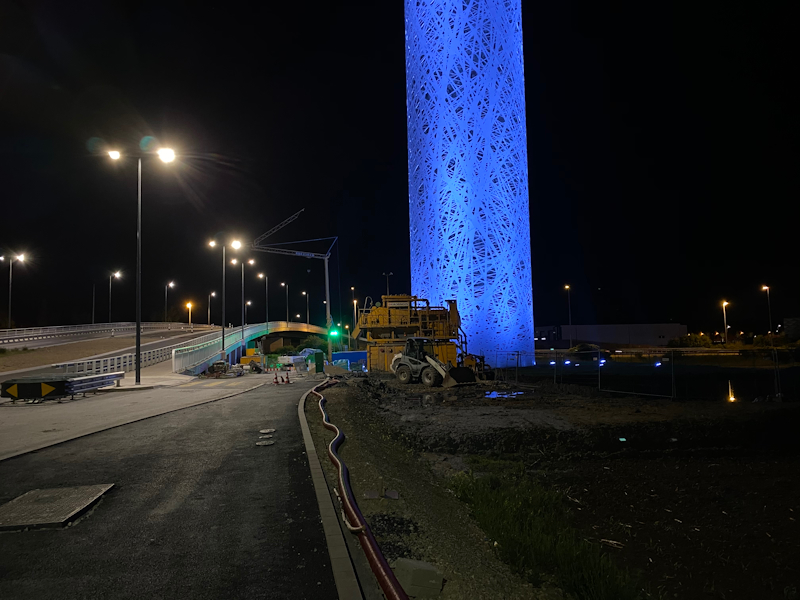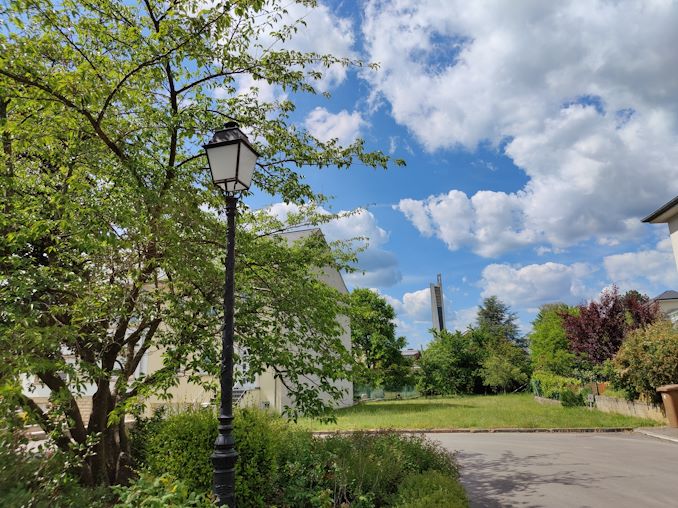The OnePlus 8, OnePlus 8 Pro Review: Becoming The Flagship
by Andrei Frumusanu on June 29, 2020 10:00 AM ESTCamera Recap - Amongst The Best
Last week, we published a more extensive dedicated camera article comparing a larger swath of recent flagship devices that have been released in last few months, including the new OnePlus 8 and OnePlus 8 Pro. I would suggest reading that piece for a more extensive camera analysis of not only the OnePlus 8’s, but also put in better context against its closest competitors:
Read Our Extensive Camera Evaluation For More Samples:
Mobile Flagship Phone Camera Overview 2020 H1: Still Picture Battle
I’ll quickly go over the key characteristics of the two phones in a few samples here:

[ OnePlus 8 ] - [ OnePlus 8 Pro ]
[ iPhone 11 Pro ] - [ iPhone SE ] - [ Pixel 4 ]
[ Galaxy S20U(S) ] - [ Galaxy S20+(E) ]
[ V60 ] - [ Mi 10 Pro ]
[ Mate 30 Pro ] - [ P40 Pro ]
[ Reno3 Pro 5G ] - [ Reno3 Pro ]
[ X-T30 ]
Between the 8 Pro and the regular 8, it’s generally evident that the 8 Pro has the better picture quality thanks to better detail retention and more dynamic range. The phone’s processing is generally amongst the best and competes with Samsung and Apple in terms of handling of tones, although the OnePlus phones more often seem to miss having the better exposure handling, such as in the above scene where both phones are flattening the highlights too much.
In terms of the phones’ main camera 48MP capture modes, it’s the 8 Pro that is the clear winner as the bigger pixels of the superior sensor are able to capture and retain more fine details.
A negative for the phone’s camera processing is that OnePlus continues to apply an artificial darkening filter on the shadows, whilst this increases the contrast of the scenes, it creates unnatural images with elements that nearly clip to black, something that had been introduced last year on the OnePlus 7 Pro as an attempt to copy the Pixel 3’s look – which Google ironically had fixed this aspect on the Pixel 4.

[ OnePlus 8 ]
[ OnePlus 8 Pro ]
[ iPhone 11 Pro ] - [ iPhone SE ] - [ P4 ]
[ Galaxy S20U(S) ]
[ Galaxy S20+(E) ]
[ V60 ]
[ Mi 10 Pro ]
[ Mate 30 Pro ]
[ P40 Pro ]
[ Reno3 Pro 5G ]
[ Reno3 Pro ]
[ X-T30 ]
In terms of telephoto photography, the OnePlus 8 Pro notably is the better phone as it features a dedicated camera module for this task, whilst the OnePlus 8 has to make due with digital cropping, although it’s not as bad thanks to the switch to the camera’s switch to their native 48MP modes.
In the ultra-wide photos, the OnePlus 8 Pro is again the clear winner thanks to its hardware advantages, achieving better details and dynamic range. Both phones are able to showcase good results, although colours aren’t as realistic as on Apple’s and Samsung’s ultra-wides.

[ OnePlus 8 ]
[ OnePlus 8 Pro ]
[ iPhone 11 Pro ] - [ iPhone SE ] - [ Pixel 4 ]
[ Galaxy S20U(S) ]
[ Galaxy S20+(E) ]
[ V60 ]
[ Mi 10 Pro ]
[ Mate 30 Pro ]
[ P40 Pro ]
[ Reno3 Pro 5G ]
[ Reno3 Pro ] - [ X-T30 ]
In low-light photography, OnePlus has been able to make major leaps forward in terms of quality thanks to improved software processing. It’s especially the OnePlus 8 Pro which has the quality lead as the phone’s superior camera sensor showcases a clear advantage to that of the OnePlus 8. In fact, the OnePlus 8 Pro consistently fared as amongst the best performers in low-light photography now, sometimes ending up as the top performer thanks to its excellent new Nightscape implementation.
The 8 Pro’s comparatively large ultra-wide module sensor also means that it’s amongst the best performers in low-light, only being beaten by the even larger sensors of Huawei devices.
One aspect we didn’t cover in our camera comparison article was the OnePlus 8 Pro’s “colour filter camera”. First of all, OnePlus did an absolutely abysmal job in actually describing the technical aspects of this camera and what it actually does. Although switching to this camera module is amongst the colour filter options in the camera UI, its effects are anything but a filter.
Any camera sensor and module on any device out there is able to capture infra-red light by default – it’s just that usually to limit the wavelengths that it sees to that of a human eye, vendors employ an IR blocking filter layer between the camera sensor and the optics. In the OnePlus 8 Pro, this layer is missing, and thus this extra camera module is able to actually capture infrared wavelengths. In fact, hobbyists out there even actively modify their digital cameras to remove this filter to achieve IR photography.
The fact that OnePlus hasn’t been able to explain the technical details of this module in their marketing materials is extremely unfortunate as there’s been a ton of misunderstanding as to what it actually does – even going so far that there’s been a backlash with privacy concerns as the camera can see through some materials that are transparent to IR light but opaque to visible light, with OnePlus even saying they’ll be removing the feature in a software update. I no longer have the phone so I don’t know if it’s actually been disabled or not, but I do find it a pity if it’s gone as it was able to achieve some very unique pictures, especially of vegetation in sunlight.
Read Our Extensive Camera Evaluation For More Samples:
Mobile Flagship Phone Camera Overview 2020 H1: Still Picture Battle
Overall, the OnePlus 8 Pro and OnePlus 8 are both good camera shooters. The regular OnePlus 8 doesn’t convince as much as its hardware disadvantages are clearly limiting what it can achieve. In this regard, the pictures it’s able to produce are adequate but it has trouble compete with the quality of the competition.
The OnePlus 8 Pro is a much better choice if you value the camera experience. OnePlus has made big leaps in the processing and picture quality. In daylight it competes with Apple and Samsung – although I still do think the phone’s shadow handling is too artificial an unrealistic – but that’s a subjective opinion. In low-light, thanks to the new processing and upgraded sensor hardware both on the main sensor and the ultra-wide camera, the OnePlus 8 Pro consistently is amongst the best performers in low-light. Overall, the 8 Pro delivers an excellent camera capture experience that’s plenty versatile.














92 Comments
View All Comments
golemB - Monday, July 6, 2020 - link
Really, superflex? You had to go to racism?Kishoreshack - Monday, June 29, 2020 - link
This phone is even better than the s20 line & way cheaper than themOnePlus is the pioneer of android os at this moment
The only complain I would have is from One plus 7 pro
Went from full screen to a punch hole in the screen
I mean these people spend soo much on screen technology & then punches a hole in the screen which cuts out content
Kishoreshack - Monday, June 29, 2020 - link
Very important questionHas one plus done a very good job with 4500mah battery or
Samsung has done a bad job with it's 5000mah battery?
Andrei Frumusanu - Monday, June 29, 2020 - link
They're both falling within the same range in terms of efficiency.Kishoreshack - Monday, June 29, 2020 - link
The best part of this phone is it's competitively priced in IndiaIt's an absolute steal for that price
It outdoes S20 line up in majority of things & is way cheaper than it
Dexter101 - Monday, June 29, 2020 - link
In the Indian market Oneplus phones are pretty good with their pricing, though I don't see how they beat the S20 line 'in a majority of things'. What things does it do better that a user notices day to day?flyingpants265 - Monday, June 29, 2020 - link
No front stereo speakers = no buy. I refuse to cup my hand around a phone to try to hear it in all conditions over background noise, whether home or outside. All phones should have front stereo speakers, there's absolutely no excuse not to have them, they can be mostly hidden behind glass.Is that a typo in the title?
Andrei Frumusanu - Monday, June 29, 2020 - link
It does have stereo speakers, albeit the bottom one is traditional bottom firing. What title?Maxpower2727 - Monday, June 29, 2020 - link
Like basically all other flagship phones, this has a front-firing speaker at the top of the phone and a bottom-firing speaker at the bottom, which is a stereo configuration and sounds great (no cupping needed). There are no manufacturers making flagship phones with dual front speakers, so unless you want to keep using an old phone, you're going to be out of luck.flyingpants265 - Monday, June 29, 2020 - link
No, it doesn't sound great, it sounds weird. The directionality of the sound is noticeable, it's awkward and unnecessary when I could just have loud, clear speakers facing me directly, like in landscape mode watching a movie or playing a game with a controller. The only reason we don't have front speakers on every phone is that companies want to save 2mm and $2 on a $999 phone, and you've been taught to accept it, just like the lack of a headphone jack.And not true, the Xiaomi Black Shark and Nubia Red Magic have front stereo speakers. They might be my only choice at this point, too bad they're missing other useful features.